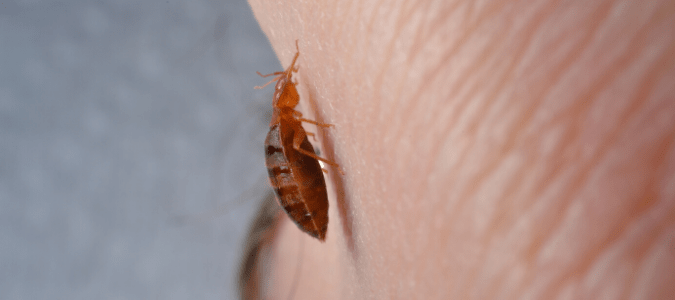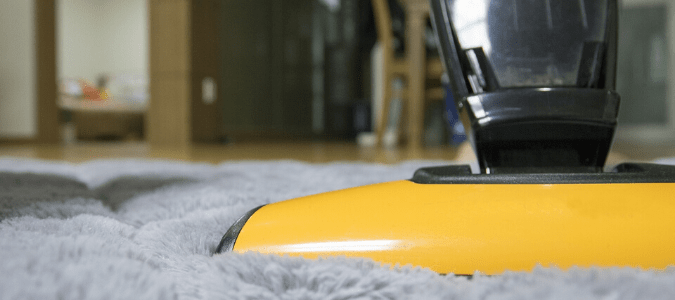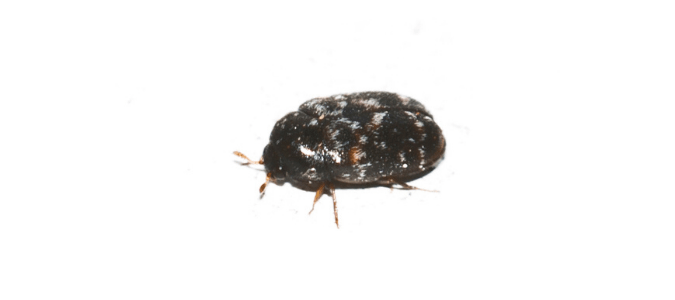
If you’re currently dealing with a bed bug infestation, or wonder if what you have seen in your home are bed bugs, you probably are wondering where these pests can be hiding. Since we typically can’t feel a bed bug bite, it can be difficult to know when we are getting bitten, even if we understandably assume it’s in our beds. To make matters even more complicated, some people don’t have an allergic reaction to a bed bug bite until as long as two weeks after it happens. With that in mind, how can you find these tiny pests? Can bed bugs hide in your carpet? Where else do they tend to spend time?
Yes, bed bugs can live in carpet, as well as in and around just about every upholstered surface in your home. A bed bug’s narrow body lets it hide easily in the smallest cracks and crevices, including upholstery seams and the gap between baseboards and carpet. However, the most frequent hiding place for bed bugs is at the edge of a mattress, usually by the headboard. Here, the bugs can remain close to people for long periods of time and stay undetected and protected. While you may find the largest concentration of these creatures around your bed, you can also find bed bugs in couches, underneath mattresses and at the edges of carpets. Anywhere that is rarely disturbed, dark and relatively close to where people spend lots of time is fair game.
Unfortunately, with bed bugs becoming more common across the country, there are even more ways than ever to come into contact with these pests. Hotels are no longer the only place you can pick up some unwelcome hitchhikers and bring them home. Bed bug infestations are increasingly common on planes, in airports and even in restaurants and schools. When you visit an infested place, it’s all too easy for these pests to crawl into backpacks, purses or luggage, often resulting in an infestation in your home.
However, bed bugs aren’t the only pest that likes to live near people in out of the way areas. There are many other pests that thrive in the exact same conditions. Fleas, for example, are also blood-feeding pests that can live on upholstery. To the untrained eye, these two creatures can look very similar.
There are a few important differences you can look for to determine if you have bed bugs or fleas.
Bed bugs are:
- The shape and size of apple seeds
- Typically the most active at night
- Usually found in beds, upholstery or furniture
Fleas are:
- About the size of the tip of a ballpoint pen
- Most noticeably active during the day
- Usually found on pets or pet bedding, or in carpets, although you can have fleas with no pets
The big difference between the two is where the bugs are found. While fleas can live on upholstery, they prefer to spend their time on the fur of animals, as it provides them protection and a convenient food source. Bed bugs, on the other hand, only stay on people for the amount of time it takes to feed. Then, they return to hiding spots nearby.
If you’re not sure what kind of bug you’re dealing with, your best option is always consulting with a professional. Pest control technicians are very familiar with the appearance and habits of both of these pests, and they will be able to tell you what’s in your home, and most importantly, what to do about it.
If you’re worried about a bed bug infestation in your home, you can do your own preliminary inspection while you are waiting for expert advice. If the infestation is bad, you should be able to find some signs of a problem. Bed bugs are sneaky, though. Even if you don’t see signs of an infestation, you may still have a problem.
How To Perform A Bed Bug Inspection
To find bed bugs, you have to know where to look. The first place to check is your mattress. Strip the sheets and put them in a plastic bag, so you don’t accidentally transport bed bugs somewhere else. Then, check your mattress for small reddish stains or black spots. These spots are usually either in places where bed bugs were crushed or are actually bed bug feces. You should also look for eggs, which are tiny white dots, although they can be hard to spot with the naked eye. And, of course, keep an eye out for live bed bugs themselves. You may find it’s easier to perform this inspection with the help of a flashlight.
Live bugs will be clustered at bedding and mattress seams, edges and piping. They can also be hidden inside the box spring. If there’s a serious infestation, you can shine a flashlight into spaces like the gap between carpet and baseboards to see live bugs.
Any search you do on your own should only be considered preliminary, as a professional is better suited to conduct a thorough evaluation. Professional pest control technicians do these types of inspections day in and day out and will know exactly where and what to look for. Once they have a good idea of what type of pest you are dealing with, they can then create a thorough treatment plan just for your situation.
There are a few things you can do to eliminate some of these pests while you wait for a professional treatment place to be put into place.

How To Get Rid Of Bed Bugs From Carpet And Rugs
Vacuuming can be effective at removing some bed bugs from your carpets. While it likely won’t get rid of all the eggs or bugs, it will help cut down on the number of these creatures that are living in your home and reproducing. When vacuuming for bed bugs, you need to use the strongest suction possible because bed bugs can hide deep in your carpets and furniture. To target edges more effectively, use the crevice attachment to focus on seams, cracks and crevices where bed bugs commonly stay hidden from view.
While spot treatments can be effective at targeting common problem areas, the most effective full-home method available is heat treatments. While bed bugs are highly acclimated to live indoors, they die after being exposed to temperatures over 122 degrees Fahrenheit. You can treat your own sheets, furniture covers and laundry by placing potentially infested items into a clothes dryer on the highest heat setting. Heat treatments can be effective on larger scales as well, but this requires specialized equipment and taking precautionary measures to protect your belongings from damage. A professional bed bug control specialist can advise you on the most effective treatment options available and any necessary follow-up to avoid a reinfestation.
Most homeowners find that DIY methods fall short and only result in making the infestation more prolonged, which can take a huge emotional toll. While there are pesticides you can purchase at a store, if you don’t know what you are doing, you could do more harm than good. Also, while some people may recommend you use gasoline or rubbing alcohol to kill the bugs, neither of these methods kill bed bug eggs and these methods only kill the bed bugs that they touch—not any of the bugs that are hiding deep in mattresses and furniture. You also want to consider that don’t want gas, rubbing alcohol or some other active ingredients in these products on materials that you use on a daily basis.
Most public institutions, including the Environmental Protection Agency, recommend contacting a pest control professional and following the recommendations you are given rather than attempting control by yourself. A professional will understand how to safely treat the problem in a way that ensures the bugs have been eliminated while keeping your health in mind. Furthermore, a pest control professional will be able to confirm the species of pest that is living in your carpet, as there are many different species of pest that can be found in carpeted areas, including carpet beetles.

Carpet Beetles Vs. Bed Bugs
A carpet beetle, which is pictured above, is another type of bug that can get mistaken for a bed bug. Since both creatures are commonly found on carpets and by baseboards, it’s an easy mistake to make. One important distinction is that while bed bugs feed on humans, carpet beetles are a nuisance pest that consumes furniture padding and coverings. Telling the two apart can help you decide what kinds of measures you should take to remove these unwelcome guests.
Bed bugs are:
- Reddish-brown
- Flat
- Biting pests
Carpet beetles are:
- A variety of colors, but frequently black or yellow with spots
- Shaped like a ladybug
- Capable of causing dermatitis
- Flying insects
Carpet beetles and bed bugs look quite different. There are multiple kinds of carpet beetle, but they are all shaped like ladybugs. Bed bugs, on the other hand, more closely resemble flat apple seeds. Carpet beetles tend to have mottled colors, from black to brown to yellow, while bed bugs are a flat tan to reddish-brown color. Perhaps the biggest difference is that carpet beetles have wings and can fly, whereas bed bugs can’t.
If you can find larva, the two species look very different. Baby bed bugs look like tiny, white, adult bed bugs. On the other hand, carpet beetles start out more like caterpillars or like fuzzy worms.
Carpet beetles don’t feed on blood. Instead, these insects prefer natural substances, especially plant-based food sources. They can easily eat their way through your carpet, silk, fur and natural fiber fabrics. Vacuuming can remove many of a carpet beetle’s food sources, including loose fibers from furnishings, pet hair and human hair. Steam cleaning can kill carpet beetles and their eggs and some items can be treated in cold storage, such as furs.
Exposure to beetle skins, fragments, feces or dusts can trigger an allergic reaction. The rash caused by carpet beetles can look very similar to bed bug bites. If you’re dealing with a rash and you’re not sure whether it’s dermatitis or bed bug bites, a pest control professional can conduct an inspection to let you know what pest has infested your home and recommend a course of treatment.
ABC Can Handle Your Pest Problems
Whether you’re dealing with dermatitis, itchy bites, lost sleep or another problem altogether, you’re likely irritated and ready for these pests to be gone. The highly-trained specialists at ABC Home & Commercial Services are fully equipped to identify the species of pest in your home and then create an effective pest control solution. We can make your life easier by helping you feel comfortable in your home again.
